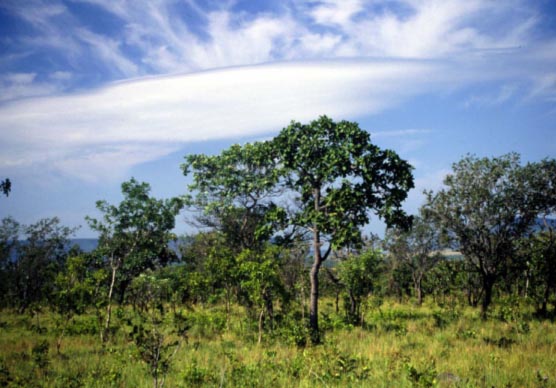Tropical Forests And Climate Change
Published on 9 February 2010 in Ecosystems and biodiversity
Introduction
Much research has focused on how the world’s tropical rain forests will react to climate change, but less attention has been paid to the vegetation that may replace them if tropical climates become warmer and drier. Various types of tropical vegetation occupy areas that are currently seasonally dry and are comprised of species that can tolerate more drought stress and higher maximum temperatures than rain forest species. It is these species that are likely to replace rain forest species in future warmer, drier climates.
Key Points
- Insufficient attention has been paid to the kind of vegetation that may replace tropical rain forests as climates change.
- If climates are to become drier and warmer, studying present-day vegetation growing in seasonally dry areas of the tropics is important.
- Insights into future changes in the distributions of tropical species can be gained from historical studies of past vegetation changes.
- In considering the fate of Amazonia, the world’s largest rain forest area, it is vital to distinguish species adapted to two major dry vegetations: savanna and seasonally dry tropical forest.
Research Undertaken
Research relevant to understanding how tropical vegetation will change in different climates takes several forms, including:
(i) ecological studies to understand the key environmental factors controlling species distributions;
Scotland has a long history of studying the neglected dry formations in Latin America. George Gardner was one of the first western explorers to document the huge expanses of dry forest and savannas (“cerrado”) of Brazil in the early 19th century, and a set of his plant collections is now housed at the Royal Botanic Garden Edinburgh (RBGE).
In the 1960s, RBGE began a continuing programme of botanical exploration in the same area, with particular focus on the cerrado savannas, which occupies two million square kilometres (the size of western Europe) in central Brazil. A major outcome of this work, which included collaboration with soil scientists from the Universities of Newcastle and Edinburgh, was the demonstration that differences in geology and soil underlie the distinction of savanna from seasonally dry tropical forest. These formations can grow side-by-side under the same climate but on different soils. Savanna, which is an open, flammable, grass rich, evergreen formation, grows on poor, acid soils, whereas closed canopy, deciduous seasonally dry tropical forests grow on richer, high pH soils often underlain by calcareous bedrock. These formations share few species in common, and both occur around the Amazon basin. It therefore seems likely that a major control of which drought-adapted species will enter the Amazon if climates dry is soil type, but as yet such edaphic factors are not part of dynamic global vegetation models that are used to predict future vegetation cover.

Image: open, grass-rich savanna in central Brazil

Image: Cactus rich seasonally dry tropical forest in Andean Peru
(ii) historical studies using fossil pollen and DNA sequencing.
The use of DNA markers has revolutionised our ability to make inferences of the demographic history of plant populations and the evolutionary history of plant species. Research at RBGE with several international collaborators (especially Geneva Botanical Garden) has used these techniques to understand the effects of recent Ice Age climates on the distribution of species and of more ancient events on the evolution of lineages. Population genetics indicates that two seasonally dry tropical forest tree species were more widespread in eastern Brazil, implying a wider expanse of this vegetation, possibly during the Ice Ages. Inferences of evolutionary history based upon DNA sequencing suggest remarkable persistence of up to 10 million years of seasonally dry tropical forest species in isolated dry forests in the Andes mountains. The survival of these species through numerous past climatic vicissitudes indicates that they could be important resources for the future.
Studies of fossil pollen from lake sediments in lowland Bolivia at the margin of the Amazon basin carried out at the University of Edinburgh in collaboration with RBGE demonstrate rapid changes in vegetation correlating with climate changes since the last Ice Age. RBGE botanists and Brazilian collaborators have documented clear movement of the boundary between the Amazon rain forest and its neighbouring savannas since the 1960s. Both these studies indicate that future vegetation change at the Amazon boundary will be rapid, and underscore the need to understand the species and vegetation in this zone of ecological transition.
Policy Implications
Adaptation to current and future climate change is an essential part of preparing for a sustainable future. Tropical forests play a vital role in regulating local and global climate, and in the carbon cycle. Understanding the tropical forests of the future is a key issue in earth system science.
Author
Dr Toby Pennington, Head, Tropical Diversity Programme, Royal Botanic Garden Edinburgh t.pennington@rbge.ac.uk





